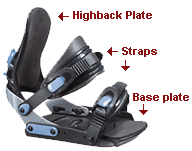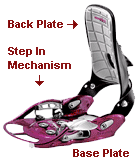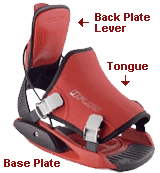| Bindings connect your boots and thus your body to your snowboard and are thus an essential part of snowboarding. Boots and bindings form a combination where not all kinds of bindings are suited for each type of boot. It is often best to buy them together and you will defenitely need to know what your intended ridings style is before you buy a combination of boots and bindings. There are a couple of types of Snowboard Bindings which we will investigate in this section. |
| Highback/Strap Bindings |
 These bindings consist of a contoured base plate where a rider can place his soft boot upon. At the back of the base plate is vertical plate (the highback) that rises behind your ankles and lower calves. The highback secures heel of your feet and backside of your lower legs. At the front of the binding are two or three adjustable straps which can be used to secure the front side of your feet and ankles to the snowboard. The combination of the highback plate and the frontside straps give great control. These type of bindings are used in combination with soft boots. As the binding gives all the support needed, the boot can remain soft and comfortable. Highback bindings can differ in the number of straps and the shape of the base plate and highback plate. Alpine riders who need to perform high speed turns will prefer taller and stiffer highbacks for greater controle and improved edge control. Freestylers will want a shorter backplate for more flexibility and turning power. Most people go for these kinds of bindings as they are more common, offer excellent control and offer more options when it comes to boots-binding combinations. Almost all soft boots can be used with any kind of Highback binding. These bindings consist of a contoured base plate where a rider can place his soft boot upon. At the back of the base plate is vertical plate (the highback) that rises behind your ankles and lower calves. The highback secures heel of your feet and backside of your lower legs. At the front of the binding are two or three adjustable straps which can be used to secure the front side of your feet and ankles to the snowboard. The combination of the highback plate and the frontside straps give great control. These type of bindings are used in combination with soft boots. As the binding gives all the support needed, the boot can remain soft and comfortable. Highback bindings can differ in the number of straps and the shape of the base plate and highback plate. Alpine riders who need to perform high speed turns will prefer taller and stiffer highbacks for greater controle and improved edge control. Freestylers will want a shorter backplate for more flexibility and turning power. Most people go for these kinds of bindings as they are more common, offer excellent control and offer more options when it comes to boots-binding combinations. Almost all soft boots can be used with any kind of Highback binding. |
| Step-In Bindings |
 Highback bindings are pretty hard to get into as you need to loosen and tighten the straps every time you get into and out of your bindings. This is the reason that Step-in Bindings were developped. Step-in bindings usually work in combination with soft boots that are somewhat stiffer than those used with highback bindings. In general step-in bindings make it easier to get in and out off but you pay for this convenience when it comes to control. There are however some higher end more advanced step-in bindings out on the market that provide the best of both worlds. Choosing step-in bindings narrows your choice when it comes to chosing boots and bindings as they need to support the same system of stepping in. Cross-over skiiers will often feel comfortable with step-in bindings and boots as they are already used to stepping in and to harder boots. Highback bindings are pretty hard to get into as you need to loosen and tighten the straps every time you get into and out of your bindings. This is the reason that Step-in Bindings were developped. Step-in bindings usually work in combination with soft boots that are somewhat stiffer than those used with highback bindings. In general step-in bindings make it easier to get in and out off but you pay for this convenience when it comes to control. There are however some higher end more advanced step-in bindings out on the market that provide the best of both worlds. Choosing step-in bindings narrows your choice when it comes to chosing boots and bindings as they need to support the same system of stepping in. Cross-over skiiers will often feel comfortable with step-in bindings and boots as they are already used to stepping in and to harder boots. |
| Flow In Bindings |
 Flow In Bindings are pretty new and try to combine the control of strap on bindings with the ease of step in bindings. The bindings look pretty simular to highback bindings and also use soft boots. The most important difference is the fact that the highback can be levered backwards creating an opening for your softboot to enter in. Instead of two or three straps to cover the top of your feet, there is one large tongue that covers a very large part of the top of your boots. Getting into and out off your bindings is a matter of flipping the highback backwards and entering or exiting your boot. People love the flow in system as it combines all the advantages of the highback bindings with the ease of step ins. One disadvantage however is that flow in bindings are less easy to adjust than strap ons. Flow in bindings are growing in popularity as the choices and techniques improve. Flow In Bindings are pretty new and try to combine the control of strap on bindings with the ease of step in bindings. The bindings look pretty simular to highback bindings and also use soft boots. The most important difference is the fact that the highback can be levered backwards creating an opening for your softboot to enter in. Instead of two or three straps to cover the top of your feet, there is one large tongue that covers a very large part of the top of your boots. Getting into and out off your bindings is a matter of flipping the highback backwards and entering or exiting your boot. People love the flow in system as it combines all the advantages of the highback bindings with the ease of step ins. One disadvantage however is that flow in bindings are less easy to adjust than strap ons. Flow in bindings are growing in popularity as the choices and techniques improve. |
| Plate Bindings |
 Plate bindings consist of a hard base plate, steel bails and a heel or toe lever. These type of bindings are used in combination with hard boots that can be inserted into the bails. By flipping the lever the boots are strapped firmly into the bindings. Plate bindings and hard boots are mostly preferred by alpine racers who need the extra edge control that they get from this combination. Plate bindings consist of a hard base plate, steel bails and a heel or toe lever. These type of bindings are used in combination with hard boots that can be inserted into the bails. By flipping the lever the boots are strapped firmly into the bindings. Plate bindings and hard boots are mostly preferred by alpine racers who need the extra edge control that they get from this combination. |